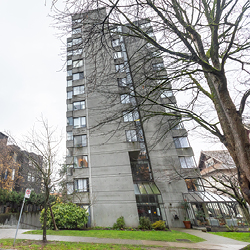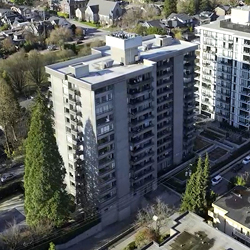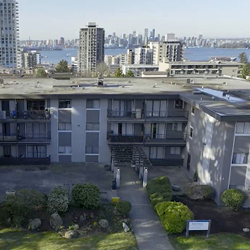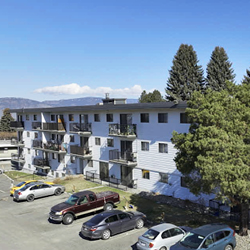Deep Energy Retrofit Pilot Program

Please note: the Deep Energy Retrofit Pilot Program is currently in the construction and evaluation phase and is now closed to new participants.

Lowering carbon emissions from existing buildings plays a key role in helping B.C. meet its climate action goals. We developed the Deep Energy Retrofit Pilot Program to improve the building envelopes and mechanical systems of 20 homes and four multi-unit residential buildings across the province. The goal of this pilot is to lower their energy use and associated emissions by at least 50 per cent.
What’s a deep energy retrofit?
A deep energy retrofit aims to improve the energy performance of existing homes and buildings using a holistic approach that targets improvements in two major areas:
- the building envelope (including walls, windows, doors, and insulation)
- mechanical systems (heating, hot water and ventilation)
Deep energy retrofits help make the whole building more airtight and well-insulated as well as upgrading mechanical systems to high efficiency. The goal is to reduce whole-building energy use by at least 50 per cent.
Why are deep energy retrofits a priority now?
Many existing homes and buildings in B.C. were not built for optimal energy efficiency, especially those built before the adoption of the National Energy Code for Buildings in the 1990s. These thousands of homes and buildings are expected to be occupied and used for years to come. And to support provincial climate action goals, we need to not only lower their energy use and carbon emissions but also make them more comfortable and safer to live in through more frequent extreme weather.
Communities need to significantly lower carbon emissions from existing buildings to support climate action goals, and deep energy retrofits are a way to do that.
Customers who choose to designate a portion of their natural gas as Renewable Natural Gas1 (RNG) through our voluntary RNG program can help lower emissions even further.
Deep energy retrofit pilot participants
The deep energy retrofit pilot involves 20 single family homes and four multi-unit residential buildings across B.C., including the Lower Mainland, Vancouver Island, Okanagan and Kootenays. The pilot aims to:
- demonstrate a variety of energy reduction approaches and technologies
- verify energy use and lower emissions
- identify any issues with implementation or customer acceptance in real-world, lived-in homes and buildings
We hope the information gathered through this pilot supports the development of a larger-scale deep energy retrofit program for all of our customers.
Please note: the Deep Energy Retrofit Pilot Program is currently in the construction and evaluation phase and is now closed to new participants.
The 20 participating single-family homes in this pilot were built between the 1920s and 1990s. Each home receives a professional energy evaluation to determine the most cost-effective improvements for their unique situation and needs. Most homes in the pilot will receive a comprehensive retrofit package that includes:
- new energy-efficient windows and doors
- added insulation in walls, attic and/or basement or crawlspace (if required)
- improved airtightness and air sealing
- new high-efficiency furnace or boiler
- new heat recovery ventilation system
Some participants will receive additional energy conservation measures such as:
- additional wall insulation
- exterior cladding
- hybrid heating system (electric air source heat pump and high-efficiency gas furnace)
Of the four multi-unit residential buildings in the pilot, two are rental apartment buildings and two are non-profit housing buildings, and all were built in the 1970s. Each building undergoes detailed energy evaluations to determine which upgrades will be installed, as well as measurement and verification of energy savings after installation.
Project partners and implementation consultants are working together to help minimize disruptions to people who live in these buildings during the retrofit process.
Learn more about how an energy-efficiency reno helps breathe new life into an old building in our blog.
Pendrellis
Location: Vancouver
Building type: concrete high-rise, non-profit housing
Project partners: Pendrellis Society, Terra Property Management, City of Vancouver, BC Housing, BC Non-Profit Housing Association
 | Upgrades:
|
Forte
Location: Vancouver
Building type: concrete high-rise, rental apartments
Project partners: Bentall Green Oak
 | Upgrades:
|
Manor House
Location: North Vancouver
Building type: low-rise, non-profit housing
Project partners: Metro Vancouver Housing Corporation, Pembina Institute
 | Upgrades:
|
Viscount Villa
Location: Kamloops
Building type: low-rise, rental apartments
Project partners: Kelson Group, Landlord BC
 | Upgrades:
|
If you have questions about deep energy retrofits and other pilot programs, email [email protected].
1When compared to the lifecycle carbon intensity of conventional natural gas. The burner tip emission factor of FortisBC's current Renewable Natural Gas (also called RNG or biomethane) portfolio is 0.27 grams of carbon dioxide equivalent per megajoule of energy (gCO2e/MJ). FortisBC's current RNG portfolio lifecycle emissions for stationary combustion are -22 gCO2e/MJ. This is below B.C.'s lifecycle carbon intensity threshold of 30.8 gCO2e/MJ as set out in the 2024 Greenhouse Gas Reduction Regulation amendments.
2Renewable
Natural Gas (also called RNG or biomethane) is produced in a different manner than conventional natural gas. It is derived from biogas, which is produced from decomposing organic waste from landfills, agricultural waste and wastewater from treatment
facilities. The biogas is captured and cleaned to create RNG. When RNG is added to North America’s natural gas system, it mixes with conventional natural gas. This means we’re unable to direct RNG to a specific customer. But the more RNG
is added to the gas system, the less conventional natural gas is needed, thereby reducing the use of fossil fuels and overall greenhouse gas emissions.